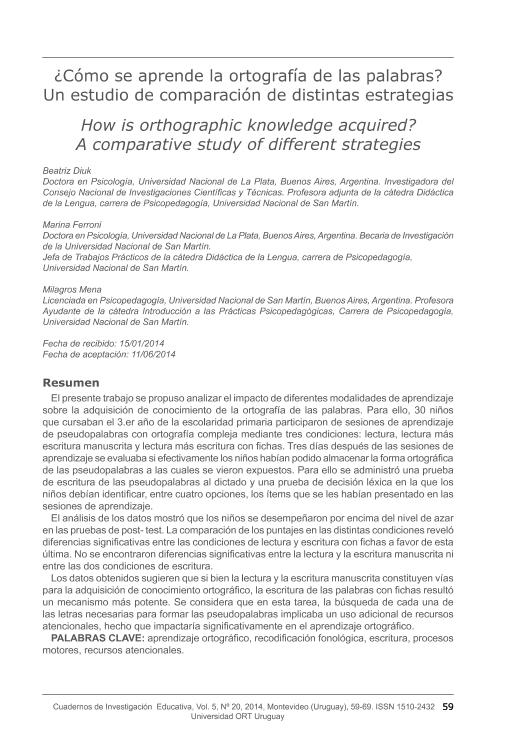Artículo
El presente trabajo se propuso analizar el impacto de diferentes modalidades de aprendizaje sobre la adquisición de conocimiento de la ortografía de las palabras. Para ello, 30 niños que cursaban el 3.er año de la escolaridad primaria participaron de sesiones de aprendizaje de pseudopalabras con ortografía compleja mediante tres condiciones: lectura, lectura más escritura manuscrita y lectura más escritura con fichas. Tres días después de las sesiones de aprendizaje se evaluaba si efectivamente los niños habían podido almacenar la forma ortográfica de las pseudopalabras a las cuales se vieron expuestos. Para ello se administró una prueba de escritura de las pseudopalabras al dictado y una prueba de decisión léxica en la que los niños debían identificar, entre cuatro opciones, los ítems que se les habían presentado en las sesiones de aprendizaje. El análisis de los datos mostró que los niños se desempeñaron por encima del nivel de azar en las pruebas de post- test. La comparación de los puntajes en las distintas condiciones reveló diferencias significativas entre las condiciones de lectura y escritura con fichas a favor de esta última. No se encontraron diferencias significativas entre la lectura y la escritura manuscrita ni entre las dos condiciones de escritura. Los datos obtenidos sugieren que si bien la lectura y la escritura manuscrita constituyen vías para la adquisición de conocimiento ortográfico, la escritura de las palabras con fichas resultó un mecanismo más potente. Se considera que en esta tarea, la búsqueda de cada una de las letras necesarias para formar las pseudopalabras implicaba un uso adicional de recursos atencionales, hecho que impactaría significativamente en el aprendizaje ortográfico. The aim of the present study was to analyze the impact of different learning modalities in the acquisition of orthographic knowledge. Thirty students in the third grade of primary education participated in pseudowords learning sessions, said words having a complex spelling. Such learning sessions were held under three modalities: reading, reading plus handwriting and reading plus spelling with letter tiles. Three days after each learning session, children were post-tested in order to determine whether they had been able to “store” the spelling of those pseudowords they had been exposed to. To such end, children were subjected to a written test where they were requested to spell the words upon dictation as well as to a lexical-decision test where they were requested to identify, out of four options, the pseudowords they had been exposed to during the learning sessions. Results showed that children performed above chance level in all post-tests. The comparison of scores in the different learning conditions revealed significant differences from the statistic viewpoint between reading and spelling with letter tiles, in favor of the latter. No differences were found either between the reading and the handwriting conditions, or between both handwriting options. The data thus obtained suggest that even though reading and handwriting give rise to orthographic learning, spelling with letter tiles provides a more powerful learning mechanism. It is considered that as children had to search for each necessary letter in order to spell the pseudowords, this implied the use of additional attentional resources which would be responsible for enhanced orthographic learning.
¿Cómo se aprende la ortografía de las palabras? : un estudio de comparación de distintas estrategias
Título:
How is orthographic knowledge acquired? : a comparative study of different strategies
Fecha de publicación:
12/2014
Editorial:
Universidad ORT Uruguay
Revista:
Cuadernos de Investigación Educativa
ISSN:
1510-2432
Idioma:
Español
Tipo de recurso:
Artículo publicado
Clasificación temática:
Resumen
Archivos asociados
Licencia
Identificadores
Colecciones
Articulos(SEDE CENTRAL)
Articulos de SEDE CENTRAL
Articulos de SEDE CENTRAL
Citación
Diuk, Beatriz Graciela; Ferroni, Marina Valeria; Mena, Milagros; ¿Cómo se aprende la ortografía de las palabras? : un estudio de comparación de distintas estrategias
; Universidad ORT Uruguay; Cuadernos de Investigación Educativa; 5; 20; 12-2014; 59-69
Compartir




